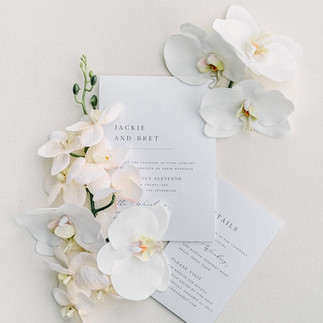How to Word a Wedding Invitation
- The Weinberg Team
- Feb 2, 2023
- 3 min read
Friends, your wedding invitation is a huge step. Yes, this step comes after the save the date. A save the date it pretty standardly an engagement photo and pretty writing with your names and the date you have set along with the location. These can be more fun! It’s like a teaser trailer for the real deal. A wedding invitation, though, sets the tone for your whole wedding. This is the first glimpse your guests get into the time, effort, and details you’ve put into your big day. Regardless of if you choose elegant or rustic, colored invitations or glossy white, floral or simple, one thing is key in all invitations: the wording. More specifically how you word the invitation. Though there are multiple ways to go about the wording, there are a few key guidelines to follow:

1. Start with who is hosting There are a lot of options with who may host the wedding: Bride’s parent’s, groom’s parents, both/all sets of parents host together, or the bride and groom.
The common formal wording through all of these is: “Mr./Doctor/Captain and/& Mrs. [man’s first name] [last name]” If both bride and groom’s families are hosting this is where you would supplement with: “Together with their families” If the divorced parents/both bride and groom’s parents are hosting you’d add an “and” and repeat so it would look like: “Mr./Doctor/Captain and/& Mrs. [man’s first name] [last name] And Mr./Doctor/Captain and/& Mrs. [man’s first name] [last name]” Lastly, if the bride and groom are hosting: [bride’s name] and [groom’s name] 2. Ask your guest to come After announcing the host, you have to actually invite the guests: Traditional- “request the honor of your presence” Casual- “would love for you to join them” Spirited- “invite you to celebrate with them” Formal- “the pleasure of your company” 3. The bride and groom’s names There is only one to follow here.
The bride’s name comes first.
That’s it. That’s the rule. Everything else is optional. You can choose to do: first and middle names; first, middle, and last names; or Miss and Mr. and many more. Whatever fits your situation best (and whatever looks best with your chosen font) is what you should choose. 4. Time/Date Numerical- more casual: 5-3-23 at 5:00 p.m. a.m./p.m. optional Spelled out- more formal: May third, twenty twenty-three at five o’clock in the evening On the third of May, twenty twenty-three and five o’clock in the evening

5. Location On the card include the name of the venue/church, city, and state, full address is optional but encouraged.
The reception information comes next. If it’s in the same place immediately following the ceremony: “reception to follow” If it’s in a different location you list the location/address of the reception: “reception to follow at [address/location]” “dinner and dancing to follow at [address/location]” If the reception is at a different location and a later time: “reception at [time] at [location]”
6. Dress code What I have learned through my research is that if you do not state a dress code, your invitation will state it for you. If you have a very formal looking wedding invitation and very formal wording, your guests will, by default, expect to dress very formal or in black tie. Same goes for casual. If you have a specific look in mind for the guest's attire, be sure to include it on your website!
7. RSVP Last, but not least by any means, have a separate card for you guests to send back and RSVP or include the link to your wedding website where they can RSVP there.
Here are some other very helpful posts on wedding invitations:
http://emilypost.com/advice/samples-of-formal-wedding-invitation-wording/
https://www.brides.com/story/guide-to-wedding-invitation-wording
https://www.marthastewartweddings.com/228634/wedding-invitation-wording?slide=764125






















Excellent guide! Wording is key to your wedding's first impression. Design and perfect your invites effortlessly with Invitationmaker.